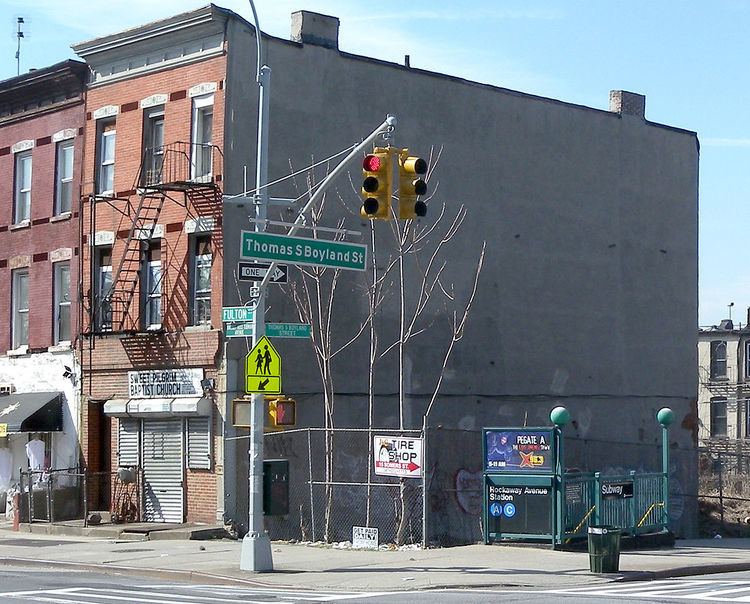Division B (IND) Transit connections NYCT Bus: B7, B25, B60 Platforms 2 side platforms Borough Brooklyn Tracks 4 | Line IND Fulton Street Line Structure Underground Opened 9 April 1936 Locale Bedford-Stuyvesant | |
 | ||
Services A (late nights)
C (all except late nights) Address Brooklyn, NY 11233, United States Similar Utica Avenue, Ralph Avenue, Van Siclen Avenue, Shepherd Avenue, Clinton–Washington Avenues | ||
Manhattan bound r160a 1 c train leaving rockaway avenue ind fulton street line
Rockaway Avenue is a local station on the IND Fulton Street Line of the New York City Subway. Located at the intersection of Rockaway Avenue and Fulton Street in Brooklyn, it is served by the C train at all times except nights, when the A train takes over service.
Contents
- Manhattan bound r160a 1 c train leaving rockaway avenue ind fulton street line
- History
- Station layout
- Exits
- References
History
When it opened on April 9, 1936, Rockaway Avenue was the terminal for IND Fulton Street Line. During this time, there was a diamond crossover between the express tracks north of the station and trains stub ended here. Between the express and local tracks in the area of the crossover were extra columns to support the subway ceiling to make up for the lack of columns that would have between the express tracks, which were not built due to the installation of the crossover. The crossover switches were controlled from a tower at Utica Avenue. The outlines of the now painted out crossovers and signals can still be seen. The levers are also still in place on the machine, but are now painted yellow and are no longer used. Meanwhile, at the nine-car stop marker on the southbound local track, there is a short section of ballasted type 1 track on both express tracks where the bumper blocks were located; when Broadway Junction opened, the temporary wooden platform extension was removed from the northbound local track only. Southbound trains continued on the local track south of Utica Avenue to the diamond crossover between the express tracks north of Broadway Junction. Trains then used this crossover to cross to the northbound express track (and another crossover to get to the local one). They then returned to either northbound track at Broadway Junction to resume service to Manhattan.
Construction on the Fulton Street Line east of Rockaway Avenue halted in 1942 due to World War II restrictions on materials. The entire tunnel infrastructure east of Euclid Avenue, including the Pitkin Yard and the yard leads, was completed, but rails and signals were not installed and Broadway Junction only had its tile completed. The tile work there is the last of the old style tiles as the tile work on the stations east is of a more modern type. Track and signals were completed into Broadway Junction in 1946 and to Euclid Avenue two years later, and the line was extended in 1946.
Station layout
This is a four-track station with two side platforms. The name tablets are white text with purple backgrounds. The top tiles of the platform walls contain purple trims with "Rockaway" written one tile below in a black background. The platforms are column-less except near the fare control areas. These are also colored purple.
Exits
The station has three exits. The full-time one is at the west (railroad north) end of the platforms. This exit has two staircases on either side of Fulton Street at Hopkinson Avenue or Thomas S. Boyland Street that lead to a small mezzanine. There is one staircase to each platform here and transfers between directions are allowed.
The other exits at the other side of the station are at platform level and unstaffed. They both have two street staircases that lead to Rockaway Avenue, but the one on the Euclid Avenue-bound platform is exit only, containing one full height turnstile, while the one on the Manhattan-bound platform has two high entry/exit turnstiles and one exit-only turnstile.
